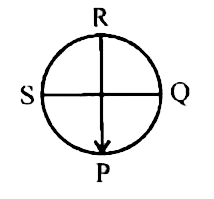A string breaks under a load of 4.8kg A mass of 0.5 kg is attached to one end of a string 2 m long and is rotated in a horizontal circle. Calculate the greatest number of revolutions that the mass can make without breaking the string.
To solve the problem step by step, we will follow the physics concepts involved in circular motion and tension in the string.
Step 1: Determine the maximum tension in the string.
The string breaks under a load of 4.8 kg. To find the maximum tension (T_max) in Newtons, we use the formula:
Tmax=m⋅g
where:
- m=4.8kg (the mass that breaks the string)
- g=9.8m/s2 (acceleration due to gravity)
Calculating this gives:
Tmax=4.8kg×9.8m/s2=47.04N
Step 2: Set up the equation for centripetal force.
When the mass of 0.5 kg is rotated in a horizontal circle, the tension in the string provides the centripetal force needed to keep the mass moving in a circle. The formula for centripetal force (F_c) is:
Fc=m⋅r⋅ω2
where:
- m=0.5kg (the mass attached to the string)
- r=2m (the radius of the circular path)
- ω is the angular velocity in radians per second.
Step 3: Equate the maximum tension to the centripetal force.
Since the maximum tension is equal to the centripetal force, we can write:
Tmax=m⋅r⋅ω2
Substituting the values we have:
47.04N=0.5kg⋅2m⋅ω2
Step 4: Solve for angular velocity (ω).
Rearranging the equation to solve for ω2:
ω2=47.04N0.5kg⋅2m
ω2=47.041=47.04
Taking the square root gives:
ω=√47.04≈6.86radians/second
Step 5: Convert angular velocity to revolutions per minute.
To convert from radians per second to revolutions per minute, we use the conversion factor 1 revolution=2π radians and 1 minute=60 seconds:
Revolutions per minute=(ω2π)×60
Substituting the value of ω:
Revolutions per minute=(6.862π)×60
Calculating this gives:
Revolutions per minute≈(6.866.2832)×60≈65.5
Final Answer:
The greatest number of revolutions that the mass can make without breaking the string is approximately 65.5 revolutions per minute.
---
The string breaks under a load of 4.8 kg. To find the maximum tension (T_max) in Newtons, we use the formula:
Tmax=m⋅g
where:
- m=4.8kg (the mass that breaks the string)
- g=9.8m/s2 (acceleration due to gravity)
Tmax=4.8kg×9.8m/s2=47.04N
When the mass of 0.5 kg is rotated in a horizontal circle, the tension in the string provides the centripetal force needed to keep the mass moving in a circle. The formula for centripetal force (F_c) is:
Fc=m⋅r⋅ω2
where:
- m=0.5kg (the mass attached to the string)
- r=2m (the radius of the circular path)
- ω is the angular velocity in radians per second.
Since the maximum tension is equal to the centripetal force, we can write:
Tmax=m⋅r⋅ω2
Substituting the values we have:
47.04N=0.5kg⋅2m⋅ω2
Rearranging the equation to solve for ω2:
ω2=47.04N0.5kg⋅2m
ω2=47.041=47.04
Taking the square root gives:
ω=√47.04≈6.86radians/second
To convert from radians per second to revolutions per minute, we use the conversion factor 1 revolution=2π radians and 1 minute=60 seconds:
Revolutions per minute=(ω2π)×60
Substituting the value of ω:
Revolutions per minute=(6.862π)×60
Revolutions per minute≈(6.866.2832)×60≈65.5
The greatest number of revolutions that the mass can make without breaking the string is approximately 65.5 revolutions per minute.
Similar Questions
A stone of mass 0.1 kg tied to one end of a string lm long is revolved in a horizontal circle at the rate of 10π rev/s. Calculate the tension in the string.
View SolutionA stone is attached to one end of a string and rotated in a vertical circle . If the string breaks at the position of maximum tension , then it will break at

View Solution
Knowledge Check
A string breaks under a load of 4 kg. A mass weighing 200 g is attached to the end of this string which is one metre long and rotation when the string breaks, Is nearly(g=10m/s2)
A16rad/sB14rad/sC12rad/sD20rad/sA stone of mass 50 g is tied to the end of a string 2 m long and is set into rotation in a horizontal circle with a uniforn speed of 2m/s .Then tension in the string is
A0.1 NB0.2 NC0.4 ND0.8 NA stone of mass 16 kg is attached to a string 144 m long and is whirled in a horizontal circle .The maximum tension the string can stand is 16 newton .The maximum velocity of revolution that can be given to the stone without breaking it will be
A2ms−1B16ms−1C14ms−1D12ms−1
A body of mass 2 kg lying on a smooth surface is attached to a string 3 m long and then rotated in a horizontal circle making 60 rev/min. Calculate the centripetal acceleration.
View SolutionIf a bodyof mass 1000 gm is tied to free end of string of length 100 cm and whirled in a horizontal circle in a second, then the tecsion in the string will be
View SolutionA stone of mass 4 kg is attached to a string of 10 m length and is whirled in a horizontal circle . Calculate the max . Velocity with which the stone can be whirled if the string can withstand a maximum tension of 160 N .
View SolutionA body of mass 2 kg is tied to the end od a string 2 m long and revolved in horizontal circle .If the breaking tension of the string is 400 N, then the maximum velocity of the body will be
View SolutionA stone of mass of 16 kg is attached to a string 144 m long and is whirled in a horizontal circle. The maximum tension the string can withstand is 16 Newton . The maximum velocity of revolution that can be given to the stone without breaking it, will be
View Solution
